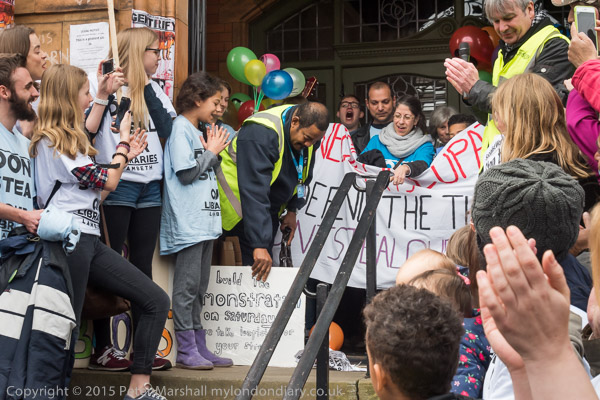Herne Hill, Dorchester and Carnegie: Another episode in in the series of posts on my walk in south London on Sunday 7th May 1989 (on earlier posts I put the date wrongly as 6th May). The walk began with Hanover, Belgrave, Chapel, Shops, Taxis. The previous post was Ruskin & Half Moon, Herne Hill.
There are some fine late Victorian houses on Herne Hill and most seemed in a good state of repair, though this one was getting some major work done. The chimneys are impressive. If you click on the image you will go to my Flickr album where you will find a couple more pictures of houses on this section of the street – and there are also a few I haven’t put online.
A little further up I came to this splendid group of 1930’s ‘moderne’ style flats. There are 96 flats in 8 blocks around a courtyard. Built in 1933-4 Dorchester Court is Grade II listed, the architects were Leslie H Kemp and Frederick E Tasker and the estate was developed by a local builder and developer, Mr Morrell. The name probably came from that of the Dorchester Hotel which had been opened in 1931 on Park Lane intended to be the perfect luxury hotel.
According to Historic England “There are structural problems with the balconies and general external deterioration. A Listed Building Consent application for the extension and refurbishment of the blocks is pending determination” and the Evening Standard in 2022 ran an article with the impresively long headline “Inside neglected Art Deco block where residents face carbon monoxide leaks, mice, cockroaches and lead pipes” stating “Residents at the Herne Hill estate are stuck in a nightmare.”
Until recently Dorchester Court was owned and neglected by the property company Manaquel, a family company whose wealth is estimated at £200 million. The Standard says they have appealed against a 2021 improvement notice from Lambeth Council and that their “endgame appears to be a full-scale redevelopment.”
The Dorchester Court Tenants Union sate that “Dorchester Court is operated by Property Partners, who are owned by Beaumaris Ventures Limited (British Virgin Islands), a financial intermediary of the IFM Group Limited (Jersey), who are both listed in the Panama Papers. Dorchester Court generates around £1.5 million in rent per year with additional income from leaseholder service charges.“
A grand pair of Italianate mid-19th century semi-detached houses, now flats, with a most unusual design. The house has now lost its white fence and rather hides behind a brick wall and a tall hedge.
I turned left into Herne Hill Road from Herne Hill, and walked along it to photograph the Haredale Road frontage of the Carnegie Library before going on to photograph the main entrance on Herne Hill Road. This Grade II listed library is one of those built with a grant from Scottish-American steel baron, Andrew Carnegie, using his vast profits from his ruthless exploitation of workers to establish over 2,800 libraries. He provided a grant of £12,500 to enable the Herne Hill Library, designed by architects Wakeford and Sons, to be built and opened in 1906.
I was back at the library in 2016 at the end of a ten days of occupation by local residents against Lambeth council’s plans to turn it into a fee-charging gym run by Greenwich Leisure Ltd with an just un-staffed lounge with books. Their occupation had hit national headlines with huge support from around the country.

The gym plans went ahead, but with a little more library provision than originally planned and there is also now the Carnegie Library Hub based in the building, “a thriving sustainable centre of local activity attractive to the whole community for developing employment opportunities, learning, fitness and wellbeing, cultural and social activity” which protects and celebrates its history and legacy.
I didn’t take many more pictures as I walked back to Herne Hill and walked back down it. After a short walk along Half Moon Lane I turned around and went towards the station, where the next part of this walk will begin.














































































